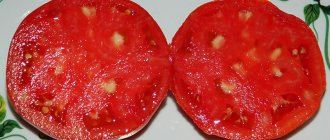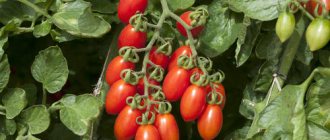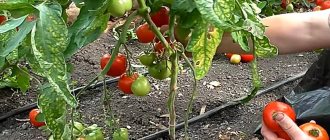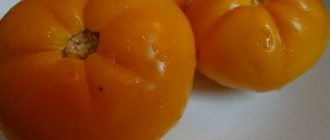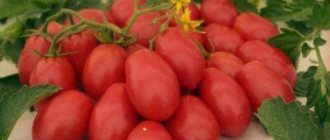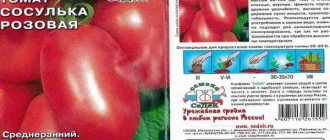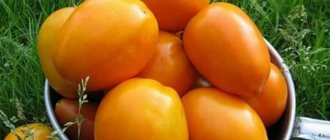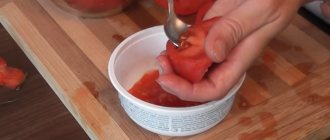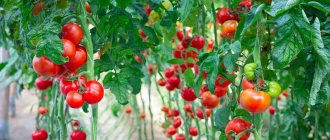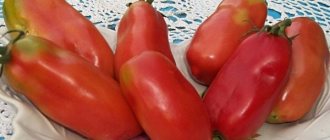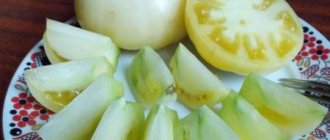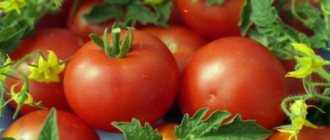The Golden King tomato (Goldene Konigin) is a constant favorite of farmers and gardeners. It is the embodiment of truly royal taste, luxurious appearance and high productivity.
| Height | Landing location | Ripening time | Fruit color | Fruit size | Origin | Fruit shape |
| Medium height | Greenhouse, Open ground | Mid-early | Yellow | Large | Variety | Heart-shaped |
Description of the variety
“Golden King” is a mid-early variety. Technical maturation occurs 100 days after the seeds hatch. Bush type: determinate, standard. The stem does not extend above 80-90 cm.
Fruit
The name of the tomato perfectly characterizes its main varietal feature - beautiful heart-shaped fruits with golden glossy skin. The size of the fruit is indeed royal - from 400 grams to 1 kg.
Overview of productive varieties:
Other important fruit characteristics:
- A large number of seed chambers - 6-7 pieces;
- High dry matter content – 5-6%;
- Fleshy pulp;
- Expressive sweet taste.
Main characteristics of the variety
Pink King is a mid-early variety, therefore, depending on growing conditions and agricultural technology, tomatoes begin to ripen on average 110 days after germination. The bush is quite tall - up to 1.8 m, so it needs tying to a support and pinching. The best yield is observed when 1 or 2 stems are formed.
The fruits are large, round in shape, weighing up to 350 grams, and fleshy. They are versatile in cooking - they look great both in salads and as ingredients in various dishes. Under ideal growing conditions, more than 12 kg of tomatoes can be harvested from one bush.
Growing area - tomato is a heat-loving plant, so it can grow in open ground only in the southern regions, for example, in the Astrakhan region; in the middle zone it can be grown in greenhouses (but the yield in greenhouse conditions is lower).
Pros and cons of the variety
Positive reviews prevail about this variety; in addition to an extensive list of advantages, tomatoes also have certain disadvantages that need to be taken into account.
Pros:
- The fruits are large.
- High yield throughout the season.
- Quite unpretentious to grow.
- Stored for a long time.
- Versatile in preparation.
- They are not afraid of many diseases and pests.
- Ovaries form in almost any weather conditions.
- Calmly tolerates lack of moisture.
- Not prone to cracking.
Minuses:
- They do not tolerate insufficient lighting well.
- If there is excessive humidity, they can develop gray rot.
- Whole fruits are not suitable for preservation.
Tomatoes: advantages and disadvantages
Advantages of this variety:
- Large fruit combined with excellent product and taste qualities;
- Fast ripening;
- High yield for a tomato with limited growth;
- Easy to care for;
- Transportability;
- Preservation for a long time.
The main disadvantage of the “Golden King” is that its fruit clusters cannot support the significant weight of the fruit, and therefore require supports. For the same reason, the main stem of the plant also requires additional strengthening.
Features of cultivation
For outdoor cultivation, southern regions such as the Astrakhan region, Crimea or the North Caucasus are more suitable for this species. In greenhouse shelters it is possible to grow in conditions of the middle zone, the yield does not decrease or decreases slightly.
Among the features of this variety are its large fruit and yellow color, which is unusual for many. It is also worth noting its resistance to many diseases. When growing, branches are pruned to form two stems; supports and branch garters are actively used to support the branches.
Harvested tomatoes tolerate storage and transportation well.
Application of fruits
The Golden King fruits are best suited for fresh consumption. Tomatoes have an attractive appearance and a beautiful cut. In addition, they have a number of unique beneficial properties :
- Contain a large amount of beta-carotene and B vitamins;
- Suitable for people suffering from stomach diseases due to its weak acidity;
- They are hypoallergenic.
Due to their gigantic size, the fruits cannot be used for whole-fruit canning or barrel pickling. However, tomatoes are successfully processed into tomato paste or lecho. The juice from the “Golden King” is unusually light and tasty, but its yield is relatively low due to the large proportion of dry matter.
Diseases and pests that the tomato is “afraid of” The King of Kings
Tomatoes King of Kings: photo of variety
If we talk about diseases and pests of tomatoes, the most common disease that affects nightshade crops is late blight. But the King of Kings tomato is resistant to it.
In this case, a pest such as whitefly poses a danger. One of the main signs that a plant has been attacked by whiteflies is that small white dots begin to appear on the underside of the leaves.
In general, whiteflies are, in principle, very dangerous pests. So you need to carefully monitor the plant. Otherwise, untimely detection of the pest can lead to the bush being completely destroyed.
To combat whitefly, you need to use some effective remedies. For example, a drug called Actellik, as well as Mospilan and Verticillin, are distinguished by their properties and effectiveness. They must be used in accordance with the instructions that come with each package, and then the plant will be under reliable protection.
Growing tomatoes
IMPORTANT : Seeds are collected only after fermentation has begun. To do this, the seed tomato is crushed and pressed by hand until a heterogeneous mass is formed. The resulting tomato slurry is poured into a jar and left at room temperature for a day or two. The main signs of fermentation are bubbles and the appearance of a white film on the surface.
Tomatoes are grown both from store-bought and from independently collected seeds. Tomatoes are selected for planting whose appearance corresponds to the standard exterior.
In most regions, tomato is cultivated through seedlings and then planted in a permanent place. In the south, seedless sowing of seeds in a greenhouse is also practiced. In the second case, seedlings are grown under a non-woven fiber cover until summer weather sets in.
How to prepare seeds?
Seeds are sold untreated, so the gardener must independently carry out all stages of pre-sowing preparation.
The procedure is as follows:
- Warming up the seed material on a radiator, stove or in the oven at a temperature of 50-60*C;
- Rejection of unusable seeds:
- Visual inspection: the seeds must be intact, without signs of damage, cracks, chips, evenly colored;
- Soak in a strong saline solution for 5 minutes. Seeds that float to the surface are subject to rejection;
- Etching in a solution of potassium permanganate;
- Growth stimulation using the following products: “Zircon”, “Kornevin”;
- Soak in warm water for several hours immediately before sowing.
Sowing seed material
Seeds are sown in March-April 1.5-2 months before planting for permanent residence. The main rule is that it is better to sow later than earlier. Firstly, late seedlings germinate faster, and secondly, you should have a couple of weeks in reserve in case of unexpected frosts - plants planted in cold soil may not produce ovaries.
As a substrate for seedlings, prepare a mixture of peat, garden turf and purchased soil in equal quantities. Any container deeper than 7 cm is used as a planting container.
The seeds are buried 2 cm, covered with dry soil and covered with polyethylene. After germination, the film is removed and the seedlings are exposed to intense lighting. The picking is carried out after unfolding the 3rd true sheet.
Rules for planting seedlings
The bushes are planted when the soil warms up to 10-12*C and there is no threat of return frosts. The planting holes are first shed with a warm solution of potassium permanganate and fertilized with vermicompost.
Recommended planting pattern:
- The interval between plants is 70 cm;
- Row spacing – 70 cm;
- Maximum planting density – 4 plants per 1 sq.m.
Description of the Golden King tomato variety, features of cultivation and care
Every summer resident grows tomatoes, only the types differ. Golden King tomatoes attract with their size, unpretentiousness and excellent taste. But these are not all the positive characteristics that it possesses.
Criteria Golden King
The description of the variety helps the summer resident make a decision on the choice, avoid mistakes when growing and correctly position the plant on the site.
- Determinant type.
- Standard.
- Height 80-90 cm.
- Ripens in 100-110 days.
- Golden yellow color.
- In the shape of a heart.
- Weighing 400-600 g, some tomatoes can reach 800 g.
- Cameras 6-7 pcs.
- It is stored for a long time, maintaining its presentation.
- Easily transports over long distances.
Sometimes the characteristics from the manufacturer are not enough and the gardener is looking for additional information, for example, the features of growing tomatoes or the use of vegetables in everyday life.
Planting seedlings
Tomatoes are mainly grown by seedlings, since direct sowing into the ground postpones the fruiting process to a later date; in some regions, tomatoes simply do not have time to ripen.
Seeds are sown 60 days before planting in a permanent place; the period is calculated by the gardener independently, based on the climate of the region.
Seedlings must be properly cared for, as this is the key to a good harvest in the future. Watering, temperature, lighting and fertilizing are the main techniques that must be followed.
Feed with growth stimulants or complex mineral fertilizers.
Tomato care
4-6 plants per 1 m2 are planted in open ground. Pre-fill the holes with humus. Golden King tomatoes require the formation of 2-3 stems.
Particular attention should be paid to tying the garter to the supports; the tassels may break off. Weeding the beds will help avoid attacks by insect pests
After watering, it is recommended to loosen the resulting crust, this will provide oxygen access to the roots.
Weeding the beds will help avoid attacks by insect pests. After watering, it is recommended to loosen the resulting crust, this will provide oxygen access to the roots.
Water the tomatoes with warm water in the evening. Feed 3 times during the season, after transplanting to a permanent place, after 10-14 days, during flowering and during the period of tomato formation.
Using tomatoes in home cooking. Harvest volume
If all agricultural technology requirements are met, 10 kg of vegetables are harvested from 1 m2.
Field health of tomatoes
An important criterion for a variety is its immunity. The golden king has complex resistance to diseases, but is still susceptible to them.
Preventive treatment is required before flowering, chemicals are used, and then traditional methods of combating diseases are used.
Advantages of the variety
The more positive characteristics a variety has, the higher the likelihood that gardeners will choose and plant it. The Golden King has the following advantages:
- High yield volume.
- Unpretentiousness of plants.
- Good commercial quality.
- Ability for long-term storage.
- Portability of transportation.
- Tomatoes do not crack.
- Sustained immunity.
- Wide range of applications.
- Requirement for formation.
- Mandatory garter to supports, possible brush breaks.
What do gardeners say about the Golden King?
Not all summer residents trust the characteristics of the producers; they look for reviews from those who planted tomatoes on their plot. Vegetable growers share their impressions and give specific advice on growing crops.
Lyubov: “The Golden King is one of the favorites on the site. The tomatoes are very tasty, meaty, not watery. In the second half of summer, a truly royal harvest ripened. Tomatoes weighing more than 400 g.”
The Golden King tomato is unpretentious and easy to grow.
Bush care
Despite their determinacy, the plants require pruning, tying to a trellis and installing additional supports for the fruit clusters. The formation of bushes begins 10 days after planting, when final rooting occurs in a new place. The bush is led into 1-2 stems, removing all side shoots that have reached 5 cm.
Other agricultural activities:
- Root watering 2-3 times a week;
Installation of a drip system is encouraged.
- Loosening the soil in combination with weeding;
- Mulching the beds with crushed straw;
- Fertilizing with NPK complexes once every 2 weeks after abundant watering.
Tomato Amber Heart F1 - description and characteristics of the variety
Tomatoes have always been of interest to gardeners for their ease of care and versatility in use. Yellow-fruited varieties are attractive due to the lack of acidity in the pulp. Amber Heart tomatoes will decorate any garden plot or greenhouse with bright golden fruits.
Description of the variety
- Amber heart F1 belongs to the hybrid group.
- Plant bushes reach a height of up to 1.1 meters.
- The leaves are medium sized, bright green. The inflorescences are tied in clusters, each producing up to 7 fruits.
- There is no need to form bushes.
- The variety is distinguished by its early ripening period; less than 90 days pass from the appearance of sprouts to the start of harvesting.
The variety is characterized by high productivity. From one square meter you can harvest up to 22 kg of ripe tomatoes. The strong skin makes the vegetables suitable for transportation to other areas without losing their marketable appearance.
Yellow fruits are suitable for salads and fresh consumption. Various preparations are made from them. Smaller tomatoes are pickled whole.
Features of agricultural technology during cultivation
Although the variety is considered unpretentious, if you follow the growing rules, you can get the highest possible yield.
- The seeds are sown at the end of March. Seeds can be treated with a growth enhancer for faster germination. The boxes are filled with soil with the addition of peat and sand, then seeds are placed in the furrows made. The top of the container is covered with glass or film. The optimal air temperature is +23-+25 degrees.
- Crops need to be provided with long daylight hours - from 16 to 18 hours. A lamp will help to accomplish this.
- At the stage of appearance of 2-3 leaves, the seedlings are planted in separate containers.
- Seedlings should be watered moderately.
- Immediately before planting in a permanent place, the plants must be hardened off. This happens by taking the seedlings out into the fresh air every day, gradually increasing the residence time. Plants should be stopped watering 3 days before planting. This will minimize the likelihood of seedlings breaking.
- Complex mineral fertilizers are first applied to the holes; this can be done in the fall. Rules for caring for plants will help you avoid various diseases, as well as get larger fruits.
Rules for caring for crops
Bushes need hilling and weeding. Plants should be watered with warm, settled water. Mulching the soil will help retain moisture longer; regular loosening will normalize air exchange in the root system. In addition, larvae of harmful insects or pathogens of viral infections may be located on the roots; if you loosen the soil, you can get rid of these scourges. The Amber Heart variety is characterized by good resistance to pests and fungi, however, for prevention, the bushes are treated with insecticides.
Gardeners have mixed opinions about the characteristics of varieties. During cultivation, it was noted that excess moisture contributes to fruit cracking. To avoid this trouble, experienced gardeners cover the bushes with non-woven material. Then, when rainy weather sets in, water does not reach the tomatoes. There are no other shortcomings in the variety.
Vitaly Sergeevich 51 years old:
I saw beautiful golden-colored fruits from my neighbors in the country, found out the name of the variety, and planted them on the property. The Amber Heart variety is quite unpretentious and does not require pinching. This significantly saves time working in the garden. The fruits are very tasty, sweet, with fleshy and juicy pulp. Tomatoes are great for fresh consumption. The remains of the harvest were preserved. I pickled small fruits. The skin is durable and does not crack during heat treatment. I advise everyone to grow this variety.
Albina V., 42 years old:
I like yellow tomatoes for their sweet taste and meaty flesh. Any summer salad of fresh vegetables with yellow tomatoes will be much tastier. I also use the Amber Heart variety for pickling and making juice. To make the color more saturated, I add red tomatoes. Caring for bushes is simple and does not require special skills. It is enough to weed, feed and water on time. The variety has a high yield from one bush; I collected about 4-5 kg of ripe tomatoes. Next year I will definitely buy the seeds of this magnificent hybrid.
Characteristics, description and photo of the variety
The variety was bred by specialists from Agro, one of the most respected breeding enterprises in the country. The “Golden” tomato was registered in the State Register in 2008 and is intended for cultivation throughout Russia in open ground and in summer unheated shelters.
Plants are determinate, low-growing. Bushes 70-80 cm high need pinching and tying to supports. Early ripening tomatoes (92-100 days from full germination), flat-round shape, leveled, weighing 100-150 g. Fruit set is friendly, high. The color of tomatoes ranges from lemon yellow to light orange.
The variety is cold-resistant and is practically not affected by late blight due to the friendly and early yield of fruits. The yield is stable, about 10 kg per square meter. Seeds collected from “your” plants can be used for sowing.
The positive qualities of the “Golden” tomato are fully confirmed by experienced gardeners. It can be recommended to novice summer residents as a reliable and virtually problem-free source of healthy and tasty fruits.
Diseases
The most common diseases that can affect a plant are fungal in nature. White, gray or brown rot destroys not only the stem, but also the fruit itself, making it unfit for consumption. Another pest will be the spider mite, which causes the bush to dry out.
The “Golden King” variety is popular due to the combination of such seemingly mutually exclusive qualities as: compactness of the bush and huge size of the fruit, exotic exterior and practicality in care. The tomato is resistant to short-term frosts, so it can be cultivated throughout Russia, including regions with risky farming.
Giant tomato:
Characteristics and description of the Golden Age tomato
The “Golden Age” tomato is included in the State Register of the Russian Federation and is suitable for growing in open ground. The vegetable is considered an excellent antioxidant, and can not only lift your spirits, but also slow down the aging process.
Tomatoes of this variety are used in cooking in many restaurants around the world.
Characteristics and description of the variety
Tomatoes “Golden Age” are a mid-season variety from varieties of determinate Siberian selection. The fruits are large-fruited, yellowish, bright and rich in color. Less often they take on a lemon tint. Tomatoes have a flat and at the same time rounded appearance, weak ribbing and a smooth surface. The berries weigh from 400 to 600 grams.
The variety is flexible and bears fruit well throughout the year. Due to the fact that the fruits are quite fleshy and have a wonderful sweetish taste and a pleasant aroma, they are consumed fresh - in salads, slices, used for winter twists in jars, and also made into juices, sauces and added to various dishes.
Advantages and disadvantages of the variety
Tomatoes "Golden Age" have a number of undeniable advantages:
- Tomatoes are stress-resistant to all weather conditions.
- The fruits are quite plastic.
- Shrubs bear fruit in any year.
- Possibility of growing in open soil and in greenhouses.
- The yield is from 5 to 6 kilograms of vegetables from one bush.
Another equally weak advantage is that these tomatoes are allowed to be consumed by people who are allergic to red varieties. “Golden Age” can be given to young children prone to allergic reactions, as well as to people on a diet or with diabetes. Ripe tomatoes cleanse the body of toxins, rejuvenate it, improve blood composition, and reduce the risk of cancer.
The only disadvantage of this variety is that if a severe drought begins in the summer, the yield will decrease from 6 kilograms to 4. But this problem can also be dealt with if you water the bushes on time - at least once a day.
Features of cultivation and care
Experienced breeders recommend growing “Golden Age” in three stems and through seedlings. As soon as the stems reach a few centimeters in height, you need to carefully tie the bushes to the supports. Stepping is a mandatory procedure that cannot be avoided. Among other growing features, farmers, gardeners and summer residents should consider the following:
- Sowing of seedlings is carried out no less than 50-60 days before you are going to plant the plant in a permanent place.
- The holes must be dug very deeply, but the beds, on the contrary, need to be raised somewhat.
- An optimal and at the same time constant temperature regime should be ensured for the seeds to germinate (23-25 degrees Celsius).
- Planted shrubs need to be covered with non-woven material or agrofibre film to provide additional warmth and protection from winds.
- Consider the size of the area when planting in the soil (about 3-4 plants should be placed per square meter).
As for watering, the “Golden Age” variety loves water very much, so in the summer and in extreme heat it is recommended to water it abundantly - twice a day, at least. Soils, both in greenhouses and open ones, need to be fed with complex special minerals. Often, manufacturers write how much fertilizer needs to be added, and the instructions themselves with a detailed description are placed directly on the packaging.
If you want to speed up the process of seed germination, quickly improve the health of shrubs, and improve the fruit set of tomatoes, then breeders recommend using special plant growth and development stimulants developed by manufacturers. Also, one of the best ways to grow seedlings is to then plant them in greenhouses.
